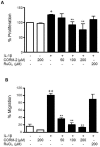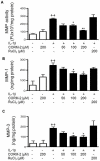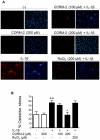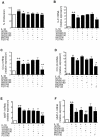Control of cell migration and inflammatory mediators production by CORM-2 in osteoarthritic synoviocytes
- PMID: 21961038
- PMCID: PMC3178532
- DOI: 10.1371/journal.pone.0024591
Control of cell migration and inflammatory mediators production by CORM-2 in osteoarthritic synoviocytes
Abstract
Background: Osteoarthritis (OA) is the most widespread degenerative joint disease. Inflamed synovial cells contribute to the release of inflammatory and catabolic mediators during OA leading to destruction of articular tissues. We have shown previously that CO-releasing molecules exert anti-inflammatory effects in animal models and OA chondrocytes. We have studied the ability of CORM-2 to modify the migration of human OA synoviocytes and the production of chemokines and other mediators sustaining inflammatory and catabolic processes in the OA joint.
Methodology/principal findings: OA synoviocytes were stimulated with interleukin(IL)-1β in the absence or presence of CORM-2. Migration assay was performed using transwell chambers. Gene expression was analyzed by quantitative PCR and protein expression by Western Blot and ELISA. CORM-2 reduced the proliferation and migration of OA synoviocytes, the expression of IL-8, CCL2, CCL20, matrix metalloproteinase(MMP)-1 and MMP-3, and the production of oxidative stress. We found that CORM-2 reduced the phosphorylation of extracellular signal-regulated kinase1/2, c-Jun N-terminal kinase1/2 and to a lesser extent p38. Our results also showed that CORM-2 significantly decreased the activation of nuclear factor-κB and activator protein-1 regulating the transcription of chemokines and MMPs in OA synoviocytes.
Conclusion/significance: A number of synoviocyte functions relevant in OA synovitis and articular degradation can be down-regulated by CORM-2. These results support the interest of this class of agents for the development of novel therapeutic strategies in inflammatory and degenerative conditions.
Conflict of interest statement
Figures










References
-
- Schedel J, Wenglen C, Distler O, Muller-Ladner U, Scholmerich J, et al. Differential adherence of osteoarthritis and rheumatoid arthritis synovial fibroblasts to cartilage and bone matrix proteins and its implication for osteoarthritis pathogenesis. Scand J Immunol. 2004;60:514–523. - PubMed
-
- Pelletier JP, Martel-Pelletier J, Abramson SB. Osteoarthritis, an inflammatory disease: potential implication for the selection of new therapeutic targets. Arthritis Rheum. 2001;44:1237–1247. - PubMed
-
- Chevalier X. Upregulation of enzymatic activity by interleukin-1 in osteoarthritis. Biomed Pharmacother. 1997;51:58–62. - PubMed
-
- Schneider N, Mouithys-Mickalad AL, Lejeune JP, Deby-Dupont GP, Hoebeke M, et al. Synoviocytes, not chondrocytes, release free radicals after cycles of anoxia/re-oxygenation. Biochem Biophys Res Commun. 2005;334:669–673. - PubMed
Publication types
MeSH terms
Substances
LinkOut - more resources
Full Text Sources
Research Materials
Miscellaneous

